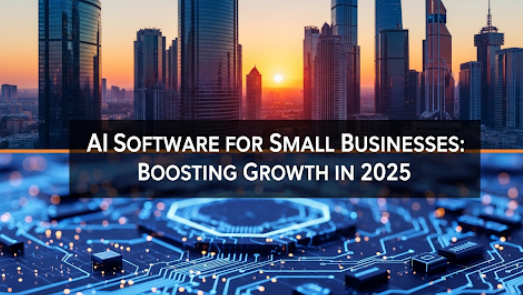AI Software for Small Businesses: Boosting Growth in 2025
Never before have small businesses faced such stiff competition. Big companies can afford to have enormous budgets to scale their business, and put entire teams of people on these ideas. However, startups should know better ways to enable this budget-and-expertise-less growth methods.
The good news? Today, AI software is cheaper and more usable than it has ever been. From 2025, AI tools will make it possible for smaller businesses to compete with the giants, as well as saving time and providing a more economic way to reach profits.
This article will demonstrate an exact method AI Software can optimize your small business operations, by revealing the best tools available in each particular field, and how you can start using them without emptying your bank account.
6 Reasons Small Businesses Should Deploy AI Software Today
It’s 2025, and the business world is so fast… They prefer getting a quick response, personalized service and seamless experiences. This can be a serious problem given how quickly small businesses can get left behind without the proper tools. This puts AI software to good use in order to democratize your industry by performing time-consuming, repetitive tasks, and gain valuable reports and data for better customer experience.
The following gives us some of the reasons why small businesses are opting for using artificial intelligence:
- Cost savings – AI tools can replace expensive manual processes
- 24/7 availability – automated systems work around the clock
- Better decision-making – analyzing data to uncover important patterns
- Improved customer experience – faster response times, and personalized interactions
- Competitive advantage – Technology becomes available once only to large corporations
Best Types of AI Software For Growing Your Small Business
Customer Service and Support Tools
Small businesses can benefit greatly by deploying AI-powered customer support solutions. These systems are able to answer frequently asked questions, book appointments and even solve basic issues without human intervention.
Popular Customer Service AI Tools:
Website & Social Media Chatbots
- Answer frequently asked questions instantly
- Collect customer information and leads
- Work 24/7 without breaks
- Cost: $20-$100 per month
AI Phone Assistants
- Handle incoming calls professionally
- Schedule appointments automatically
- Take messages and route calls
- Cost: $50-$200 per month
Email Automation Systems
- Respond to customer inquiries with great personalization
- Quotes and proposals follow up
- Organize customer communication
- Cost: $15-$75 per month
Sales and Marketing Automation
Small companies are also able to market at scale more effectively using AI tools. These tools generate content, handle social media, and track customer behavior and gauge it against performance to increase sales.
Key Marketing AI Features:
- Content creation: Writing blog posts, social media captions, email newsletters
- Lead scoring: Score qualified leads so you can determine who the potential buyers are
- Social media management: Scheduled social posts and automatic comment responses
- Email marketing: Campaign targeting ads based on user behavior
| Type of Tool | Average Cost | Great for | Time Savings Per Week |
|---|---|---|---|
| Content Creation | $25-$100/mo | Blog posts, social media | 8-12 hours |
| Email Marketing | $20-$80/mo | Customer communication | 4-6 hours |
| Social Media Management | $15-$60/mo | Online presence | 6-10 hours |
| Lead Generation | $50-$150/mo | Finding new customers | 5-8 hours |
Financial Management and Accounting
Managing money is key to small business success. AI accounting tools can track expenses, help you create invoices and even predict future cash flow problems.
AI Accounting Benefits:
Automatic Expense Tracking
- Scan receipts and categorize expenses
- Direct links to bank accounts so you can see the balance picture in real time
- Generate tax reports automatically
Invoice Management
- Create professional invoices quickly
- Send automatic payment reminders
- Track which customers pay late
Financial Forecasting
- Predict future cash flow
- Identify spending patterns
- Seasonally adjust your business plan
Inventory and Supply Chain Management
AI inventory systems can also prevent physical product sales from inventory run-out by businesses selling products. These systems keep tabs on strong sales and automatically restock items that are selling briskly.
Smart Inventory Features:
- Demand prediction: Never run out again
- Order automatically: Don’t miss sales because your shelves are empty
- Supplier management: Get the best prices and delivery times
- Reduce waste: Avoiding oversupply to slow-moving products
How to Choose the Right AI Software Tools for Your Business
There are so many AI tools to choose from it might feel like an impossible task. Here’s a step-by-step process to get the best out of what suits your business better.
Step 1: Pinpoint the Things That Take a Lot of Your Time
Review your daily routines and recognize what wastes the most time. Some of the time wasters in small businesses include:
- Replying to the same customer questions over and over
- Creating social media content
- Data entry & paperwork
- Scheduling appointments
- Following up on leads
Step 2: Set Your Budget
AI tools can be free or cost hundreds of dollars per month. Begin with a budget. Based on the law of diminishing returns, about 80% of your requirements in a good AI should be met with roughly one-third to half of this yearly budget. Take time to execute and remember that you will want your software to pay for itself by saving you time or making you more money.
Budget Guidelines:
- Basic Package: $50-$150/month for starter kit
- Scale Package: $200-$500 per month as all-in-one solution
- Budget for Scale: $500+/month (you will need it to support advanced features and integrations)
Step 3: Start Small and Grow
Do not attempt to automate everything at once. Start with one tool, figure it out and then slowly roll out AI solutions.
Recommended Implementation Order:
- Customer support (chatbots or email automation)
- Social media management
- Accounting and invoicing
- Inventory management (if applicable)
- Advanced analytics and forecasting
Step 4: Check Integration Capabilities
Select AI tools that integrate well with what you have already built. For example, if you use a given email platform, make sure your AI tool can connect to it.

Your First 30 Days: Introduction to AI
A Realistic Timeline for AI Implementation in Your Small Business
Week 1: Research and Setup
- Start with one AI tool
- Join their free trials when they are available
- Set up basic configurations
- Import existing customer data
Week 2: Training and Testing
- Understand the main functionalities of the tool
- Test automated responses and workflows
- Train your team on the basics
- Apply initial tweaks directly from the feedback
Week 3: Full Implementation
- Now release the AI tool for all operations
- Monitor performance and customer feedback
- Fine-tune automated responses
- Document what’s working well
Week 4: Optimization and Planning
- Analyze results and measure improvements
- Plan for additional AI tools
- Calculate return on investment
- Set goals for the next month
How to Measure Success: Important Metrics to Monitor
The numbers you should track to see if your AI software is working:
Customer Service Metrics:
- Time to respond to customer inquiries
- Customer satisfaction scores
- Deflection rate (no human help needed)
- Cost per customer interaction
Sales and Marketing Metrics:
- Lead generation numbers
- Conversion rates from leads to customers
- Social media engagement rates
- Email open rates in percentages and click-through rates
- Cost per new customer acquired
Operational Metrics:
- Time spent on routine tasks
- Accuracy of automated processes
- Employee satisfaction with tools
- Overall productivity improvements
Common Challenges and Solutions
The challenges small businesses face when adopting AI software are often the same. Following are the possible ones with their solutions:
Challenge 1: Team Not Adapted to Change
Solution: Begin with technology tools that help employees do their jobs easier, not harder. Demonstrate to team members how AI can free up their time for more engaging work.
Challenge 2: Technical Difficulties
Solution: Use user-friendly tools with great customer support. New customers are usually accompanied by free setup guidance from numerous AI companies.
Challenge 3: Cost Concerns
Solution: Find the actual price by time saved and revenue gained. Most AI tools generate payback within a few months.
Challenge 4: Privacy and Security Concerns
Solution: Opt for AI vendors with proven security defenses. Read the privacy policies of any service provider and understand how your data is protected.
The Future of AI in Small Businesses
The technology of AI is advancing fast. Small business owners face this exciting future:
Trends to Look Forward to:
- Cheaper AI tools that cater specifically to small businesses
- Better software integration with one another
- Voice-controlled business systems
- No-code AI services
- Increased emphasis on data privacy and security
Preparing for the Future:
- Learn about new developments in AI
- Create an innovative culture in your business
- Train and develop employees
- Make a priority of tools that scale with your business
- Find the perfect balance between automation and human intervention
Frequently Asked Questions
Q: How expensive is AI software for small businesses usually?
A: Small businesses typically spend between $50 and $300 monthly on AI tools related to their needs. There are many tools that provide free trials or basic free versions which will allow you to get started without payment upfront.
Q: Will it require technical skills to operate AI software?
A: Modern AI tools are mostly for people who aren’t technical. Most come with drag-and-drop interfaces, as well as step-by-step setup tutorials. Yet having one team member know the very basics could come in handy when troubleshooting.
Q: Is AI going to replace my employees?
A: Better for repetitive tasks, AI will help shift your workers’ attention back to creative and strategically driven work. AI has made small businesses better rather than smaller, with most businesses augmenting human abilities instead of replacing humans.
Q: How quickly can I see results from AI implementation?
A: Many businesses start saving time in the first week. Tangible results in customer service, lead generation or cost savings generally manifest within 30-60 days and the significance of the progress becomes more apparent at that point.
Q: What is the #1 mistake that small businesses make with AI?
A: Trying to automate everything at once. I suggest starting with just one tool, getting good at it, and then you can slowly add more AI solutions as your team gets comfortable with the technology.
Q: How can I determine if an AI tool is valuable?
A: Track metrics like response time improvements, sales leads, customer service satisfaction, or cost reduction. If the tool is going to make you more money than it costs, then it’s worth the purchase.
Q: Is it secure to use AI tools with customer data?
A: Choose AI vendors with reputable encryption algorithms that respect local regulations. Always read privacy policies and employ vendors that prioritize security. Look for certifications such as SOC 2 or GDPR compliance.
Taking Action: Your Next Steps
AI software represents a remarkable chance for small businesses to take on larger companies and expand like never before. Just take it slow, go in with the right tools for your particular business case and increase AI usage as it proves useful.
Keep in mind that you do not need the latest, cutting-edge technology to be successful with AI: You just have to help move the needle for your business and customers. Simply focus on tools that save time, lower costs, or increase customer satisfaction and you will observe the benefits in no time.
Those companies that will implement AI now, or who are implementing them already, will have a clear advantage when we look forward in the coming months and years. Instead of waiting for perfection and the “right” time, start with a single lightweight AI tool today and see how it levels up your operations.
With AI, in some form and functionality (budget- and technical acumen-dependent), businesses can improve customer service, automate marketing tasks or optimize financial management. The future of small business has arrived — and it is enabled by AI.

